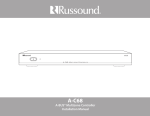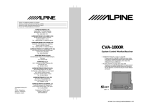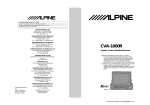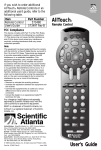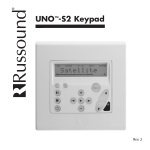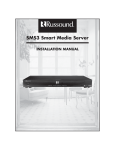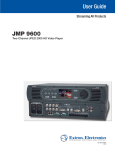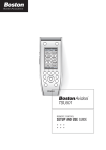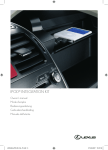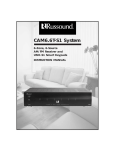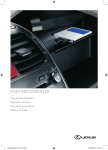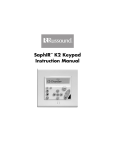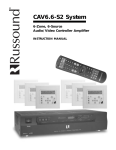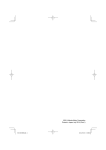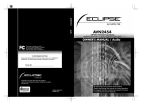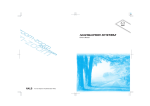Download Russound CAV66 2 Installation manual
Transcript
CAA66 Multisource Multiroom Audio Controller/Amplifier Installation Manual IMPORTANT SAFEGUARDS 10.Power Sources - The appliance should be connected to a power supply only of the type described in the operating instructions or as marked on the appliance. 11.Grounding or Polarization - Precaution should be taken so that the grounding or polarization means of an appliance is not defeated. WARNING: TO REDUCE THE RISK OF FIRE OR ELECTRIC SHOCK, DO NOT EXPOSE THIS APPLIANCE TO RAIN OR MOISTURE. CAUTION: TO REDUCE THE RISK OF ELECTRIC SHOCK, DO NOT REMOVE COVER. NO USER - SERVICEABLE PARTS INSIDE. REFER SERVICING TO QUALIFIED SERVICE PERSONNEL. The lightning flash with arrowhead symbol, within an equilateral triangle, is intended to alert the user to the presence of uninsulated “dangerous voltage” within the product’s enclosure that may be of sufficient magnitude to constitute a risk of electric shock to persons. The exclamation point within an equilateral triangle is intended to alert the user to the presence of important operating and maintenance (servicing) instructions in the literature accompanying the appliance. If you have any questions please call Russound Inc. at 1-800-638-8055 or 603-659-5170. Safety Instructions: 1. Read Instructions - All the safety and operating instructions should be read before the appliance is operated. 2. Retain Instructions - The safety and operating instructions should be retained for future reference. 3. Heed Warnings - All warnings on the appliance in the operating instructions should be adhered to. 4. Follow Instructions - All operating and user instructions should be followed. 13.Cleaning - The appliance should be cleaned only as recommended by the manufacturer. 14.Non-use Periods - The power cord of the appliance should be unplugged from the outlet when left unused for a long period of time. 15.Object and Liquid Entry - Care should be taken so that objects do not fall and liquids are not spilled into the enclosure through the openings. 16.Damage Requiring Service - The appliance should be serviced by qualified service personnel when: A. The power supply cord or the plug has been damaged; or B. Objects have fallen, liquid has been spilled into the appliance; or C. The appliance has been exposed to rain; or D.The appliance does not appear to operate normally; or E. The appliance has been dropped or the enclosure is damaged. 17.Servicing - The user should not attempt to service the appliance beyond that described in the operating instructions. All other servicing should be referred to qualified service personnel. Precautions: 1. Power – WARNING: BEFORE TURNING ON THE POWER FOR THE FIRST TIME, READ THE FOLLOWING SECTION CAREFULLY. 5. Water and Moisture - The appliance should not be used near water; for example, near a bathtub, washbowl, kitchen sink, laundry tub, in a wet basement, or near a swimming pool. 2. Do Not Touch The Unit With Wet Hands – Do not handle the unit or power cord when your hands are wet or damp. If water or any other liquid enters the cabinet, unplug the unit from power immediately and take it to a qualified service person for inspection. 6. Carts and Stands - The appliance should be used only with a cart or stand that is recommended by the manufacturer. An appliance and cart combination should be moved with care. Quick stops, excessive force and uneven surfaces may cause the appliance and cart combination to overturn. 3. Location of Unit – Place the unit in a well-ventilated location. Take special care to provide plenty of ventilation on all sides of the unit especially when it is placed in an audio rack. If ventilation is blocked, the unit may overheat and malfunction. Do not expose the unit to direct sun light or heating units as the unit internal components temperature may rise and shorten the life of the components. Avoid damp and dusty places. 7. Wall or Ceiling Mounting - The appliance should be mounted to a wall or ceiling only as recommended by the manufacturer. 4. Care – From time to time you should wipe off the front and side panels of the cabinet with a soft cloth. Do not use rough material, thinners, alcohol or other chemical solvents or cloths since this may damage the finish or remove the panel lettering. 8. Ventilation - The appliance should be situated so that its location or position does not interfere with its proper ventilation. For example, the appliance should not be situated on a bed, sofa, rug, or similar surface that may block the ventilation openings, or placed in a built-in installation, such as a bookcase or cabinet that may impede the flow of air through the ventilation openings. 9. Heat - The appliance should be situated away from heat sources such as radiators, heat registers, stoves, or other appliances (including amplifiers) that produce heat. 2 12.Power Cord Protection - Power supply cords should be routed so that they are not likely to be walked on or pinched by items placed upon or against them, paying particular attention to cords at plugs, receptacles, and the point where they exit from the appliance. TABLE OF CONTENTS USER SECTION Product Introduction ............................................................................................................5 Component Guide CAA66 Controller ................................................................................................................6 KP6 Keypad........................................................................................................................7 KPL Keypad .......................................................................................................................8 KPSC Keypad......................................................................................................................9 Numeric Entry................................................................................................................9 Prefix and Suffix Commands ...........................................................................................9 SRC1 Remote Control........................................................................................................10 Operation KP6 User Options Mode ....................................................................................................11 KPL User Options Mode.....................................................................................................12 INSTALLER SECTION Getting Started Unpacking ........................................................................................................................13 System Components .........................................................................................................13 Tools Needed....................................................................................................................13 System Installation Considerations......................................................................................13 Connection Tips ................................................................................................................13 Wiring Instructions Keypad Wiring...................................................................................................................14 Speaker Wiring .................................................................................................................14 Component Guide CAA66 Controller Front Panel Removal ...............................................................................15 CAA66 Controller Rear Panel .............................................................................................16 KP6 Keypad Update Port ...................................................................................................17 KP6 Keypad Rear Panel ....................................................................................................18 Keypad Installation KP6 Keypad Installation .....................................................................................................18 Making Connections Keypad Port Connections...................................................................................................19 Source Audio Input Connections .........................................................................................20 Source IR Connections ......................................................................................................20 RNET Source Audio Connections ........................................................................................21 3 TABLE OF CONTENTS Common IR Input Connection .............................................................................................22 Speaker Connections ........................................................................................................23 Zone Fixed/Variable Audio Output .......................................................................................24 12VDC Mute Trigger In/Trigger Out ....................................................................................25 Controller Link In/Out ........................................................................................................26 RS-232 Interface ...............................................................................................................27 Initial Hardware Install Test .................................................................................................28 Programming Programming Center .........................................................................................................29 Controller Setup Mode Controller ID ...............................................................................................................30 Number of Sources.....................................................................................................31 Factory Initialization.....................................................................................................32 Controller Setup Flow Chart ...........................................................................................33 Source Setup Mode Source Setup..............................................................................................................34 Command Type Options RNET Sources..........................................................................................................35 UEI Library ...............................................................................................................36 Learned IR ...............................................................................................................37 Invalid Code .............................................................................................................38 Clear Code ..............................................................................................................39 Source Setup Flow Chart ...............................................................................................40 KPL Setup Flow Chart ....................................................................................................41 KPL Diagnostics Flow Chart ...........................................................................................41 REFERENCE SECTION Source Names .................................................................................................................42-43 UEI Library Device Codes .................................................................................................44-46 Technical Specifications.........................................................................................................47 Warranty ..............................................................................................................................48 4 INTRODUCTION Thank you for choosing the Russound® CAA66 controller amplifier to enhance your home with distributed audio. The CAA66 caters to homeowners who want more control over their multiroom systems with such capabilities as infrared (IR) tools to manage the system from anywhere in the house. More source inputs, simplified programming and user adjustable sound controls make listening to music throughout the home easier than ever. Key features include: • Six sources delivered to any one of six zones for sharing music throughout the home. • Simplified programming and control via IR library and intelligent IR learning capabilities for quick setup. • Scalable to 36 zones by connecting multiple CAA66 units, to make whole-house audio available to larger homes. Your system can grow as your home grows. The CAA66 kit ships with a remote control (SRC1) and elegant keypads (KPL or KP6 models) for home audio one-touch control. From each keypad, the user can adjust bass, treble, balance and volume. The system supports multiple keypads per zone for convenient access and includes an RS232 connection for integration with home automation systems. Russound's controller/amplifiers meet the needs of homeowners who want to experience true audio fidelity throughout the home. And with the CAA66, customers have more home audio choices at a cost-effective price. 5 COMPONENT GUIDE CAA66 FRONT PANEL The CAA66 front panel consists of a split molded piece with a removable bottom half. This bottom piece hides the Programming Center buttons. The power switch has a push on/push off action with a blue LED 1 2 “power on” indicator to the left which illuminates when the unit is on. The six zone LEDs light up amber when the zones are active. 3 4 1 POWER ON/OFF LED - Indicates power on when illuminated 2 MAIN POWER SWITCH - Turns power on and off 3 ROOM LED INDICATORS - Indicate when a room is on (amber) or off (not lit) 4 REMOVABLE COVER - Covers the Programming Center buttons on the controller The CAA66 front panel bottom half hides the Programming Center. The Programming Center is used to perform the controller setup and source setup procedures. These are explained in detail in the Installers section of this manual. The Programming Center button LEDs light at different rates and in different colors during these proce- dures to indicate programming steps. It also contains an IR receiver window for remote control use during programming. Note: It is important to properly remove the panel to prevent damage. See page 15 for complete instructions. 1 1 6 PROGRAMMING CENTER - used to perform the controller setup and source setup procedures COMPONENT GUIDE KP6 KEYPAD 1 8 2 3 7 4 6 5 KP6 Keypad 1 SOURCE NAME - Six clear windows with replaceable source name labels. Current source selected is backlit amber. 2 VOLUME UP - Raises the volume for the room/adjusts User Menu options. 3 VOLUME DOWN - Lowers the volume for the room/adjusts User Menu options. 4 POWER - Turns zone ON or OFF when pressed once. When OFF, press and hold will turn OFF all zones. Power button remains lit when OFF if any other zone in the system is ON. 5 IR CONFIRMATION/LOUDNESS LED - Blue LED blinks to confirm IR signal reception, and remains lit when Loudness feature is enabled. 6 IR RECEIVER - Receives IR signals and passes them to the controller and source equipment. Also used when the keypad is operated using the CA System remote controls. 7 SOURCE SELECT - Press and release scrolls through the available sources. Press and hold brings up the USER MENU for Loudness, Bass, Treble, etc. 8 VOLUME LEVEL - Volume level indicator LEDs light up from left to right to indicate volume level. Also used to indicate user option settings. 7 COMPONENT GUIDE KPL KEYPAD 9 1 8 2 7 3 6 4 5 KPL Keypad 8 1 LCD PANEL - 5-character amber backlit display shows source name, volume and zone status. 2 VOLUME UP - Raises the volume for the room/adjust User Menu options. 3 VOLUME DOWN - Lowers the volume for the room/adjust User Menu options. 4 POWER - Turns zone ON or OFF when pressed once. When OFF, press and hold will turn OFF all zones.. Power button remains lit when OFF if any other zone in the system is ON. 5 IR CONFIRMATION/LOUDNESS LED - Blue LED blinks to confirm IR signal reception, and remains lighted when Loudness feature is enabled. 6 IR RECEIVER - Receives IR signals and passes them to the controller and source equipment. Also used when the keypad is operated using the CA System remote controls. 7 SOURCE SELECT - Press and release scrolls through the available sources. Press and hold brings up the USER MENU for Loudness, Bass, Treble, etc. 8 VOLUME LEVEL - 21-segment volume level bars increase from left to right to indicate volume level/indicates user option settings. 9 SYSTEM INFO - SYS On indicates other active zones and SHARED indicates the selected source is in use in another zone. COMPONENT GUIDE KPSC KEYPAD KPSC Source Control Keypad The KPSC keypad connects to a KP6 or KPL keypad to add source control and numeric capability. The amber backlit buttons provide primary source controls when pressed, such as stop, play, next, etc. When the Numeric button is pressed, it becomes backlit in red, and changes the buttons to numeric entry (0 - 9). Pressing the Numeric button also sends a Prefix command of “Disc.” A second press of the Numeric button sends a Suffix command of “Enter” and puts the keypad back into the primary control mode. If the button is not pressed the second time, a 3-second time out will send the Suffix command and exit Numeric mode. The F1 and F2 favorite buttons are programmed by a press and hold. They save current input and volume level settings for recall, and can be overwritten with another press and hold. 4 1 1 2 2 3 KPSC Keypad 1 PRIMARY SOURCE CONTROLS - Functions on outer edge of buttons are default or normal operation for each selected source. These include play, stop, forward, back, pause, etc. 2 FAVORITES - Set and recall two favorite settings of source and volume. 3 NUMERIC VALUE SHIFT - Press to shift buttons to numeric control or entry. Also issues Prefix command “Disc” and Suffix command “Enter” 4 NUMERIC CONTROLS - Once numeric control is initiated, the primary control buttons now represent the numeric value when pressed (0-9). 9 COMPONENT GUIDE SRC1 SYSTEM REMOTE CONTROL 1 POWER - Turns on or off selected zone. 2 NUMERIC INPUT - Number buttons for direct input of frequency, channel, etc. 3 VOLUME UP/DOWN - Raises or lowers the volume in the zone. 4 MUTE - Mutes/unmutes zone audio output. 5 INFO - Displays current channel and program information. 6 CURSOR KEYS - Moves the cursor in the program guide and menu screens. 7 OK - Chooses the highlighted menu option. Performs “Enter” function for devices. 8 EXIT - Exits out of the selected component’s menu or guide. 9 TRANSPORT KEYS - Controls components (Play, Pause, Stop, Forward, etc.). 10 PAGE UP/DOWN - For use with cable or satellite boxes. 11 DISC - Directly selects a disc using Numeric IR. 12 SOURCE KEYS - Selects specific sources. 13 FAVORITES - Selects and saves favorite presets. 14 GUIDE - Displays the program guide. 15 MENU - Accesses the menu of the selected component. 16 CHANNEL UP/DOWN - Incrementally scrolls through channels or tuned stations. 17 LAST - Recalls the last channel or page back one screen in the main menu. 18 INPUT - Switches sources on zone keypad. 1 2 18 17 16 3 4 15 5 6 7 14 8 9 10 13 11 12 10 OPERATION USER OPTIONS SETTINGS KP6 Keypad User Options Mode Operation Source window blinks to indicate the option that is ready for adjustment Bass Treble Balance Turn On Volume Option setting level Press and hold Source button to enter or exit User Options Mode Press Volume Up or Down buttons to adjust setting Blue LED will blink to indicate Loudness is ready for adjustment KP6 User Options Mode The User Options Mode allows the user to adjust the audio properties of a particular zone. The audio features that can be adjusted are: Bass, Treble, Balance, Turn On Volume and Loudness. The top four Source windows and the blue LED blink to indicate the option is ready for adjustment. To enter the User Options Mode, press and hold the Source button when the zone is on. A press and hold of the Source button (or a 9-second timeout) returns the keypad to regular operation. The top left (Source 1) button will temporarily blink to indicate “Bass” is ready for adjustment. Subsequent presses of the Source button toggle through Treble (Source 2), Balance (Source 3), Turn On Volume (Source 4) and Loudness (blue LED). Press Source button to select option Once an option is selected, the Volume Up/Down buttons are used to adjust settings. The volume indicator LEDs temporarily light to show the option setting. Setting Loudness In User Option Mode, the blue LED will blink rapidly when Loudness is selected for adjustment. To turn Loudness ON, press the Volume Up or Down button once. The blue LED lights solid then blinks again. To turn Loudness OFF, press Volume Up or Down once. The blue LED goes dark for a moment, then blinks again. When the keypad is in operation, the blue LED lights solid when Loudness is activated. 11 OPERATION USER OPTIONS SETTINGS KPL Keypad User Options Mode Operation Press and hold Source button to enter or exit User Options Mode Press Volume Up or Down buttons to adjust setting Press Source button to select option Blue LED will blink to indicate Loudness is ready for adjustment KPL User Options Mode Options and Settings The User Options Mode allows the user to adjust the audio properties of a particular zone. The audio features that can be adjusted are: Bass, Treble, Balance, Turn On Volume and Loudness. 1. Bass: -10 < Bass:Flat > +10 To enter the User Options mode, press and hold the Source button when the zone is on. Press and hold the Source button again (or a 9-second timeout) returns the keypad to regular operation. The first option name (Bass) appears on the display to indicate it is ready for adjustment. Subsequent presses of the Source button toggle through Treble, Loudness, Balance, and Turn On Volume. Once an option is selected, the Volume Up/Down buttons are used to adjust settings. The volume indicator bars indicate the option setting, along with setting numbers displayed on the LCD. 12 2. Treb (Treble): -10 < Treble:Flat > +10 3. Loud (Loudness) (more bass, fuller sound): On or Off (When Loudness is turned on, the blue LED lights solid) 4. Bal (Balance): Left 10 < Center > Right 10 5. OnVol (Turn on Volume) (default room volume level): 0 to 100 (in steps of 2) INSTALLER GETTING STARTED Unpacking the System Components • Keep the original carton and packing materials for future shipment or storage. System Installation Considerations There are several factors to consider before installing the Russound CAA66 system: • Check for any visible signs of damage. If you encounter any concealed damage, consult your Russound dealer before proceeding to install the unit. • What are the intended listening zones? • Retain the sales receipt as it establishes the duration of the limited warranty and provides information for insurance purposes. • From where in each zone will the user prefer to control the system? Where will the keypads be located? Where will the speakers be located? CAA66 System Components: • 6 (six) KP6 or KPL Keypads • Where will the source equipment be located? The CAA66 must have proper ventilation above and below for air circulation and heat dissipation. A rack-mount location may require fans and vents. • 1 (one) SRC1 System Remote Control Connection Tips • 6 (six) 845.1 Micro Emitters • It is recommended that the CAA66 and the source equipment be plugged into a dedicated 20-amp circuit with an isolated ground. A power line conditioner can reduce interference problems caused by noise found in some electrical systems. • 1 (one) CAA66 Controller/Amplifier Tools needed for installation: • Drill with a 1/2” x 6” drill bit • Keyhole saw • Flat head screwdriver (medium size) • Phillips Screwdriver (cordless recommended) • 110 punchdown tool (included) • Modular RJ-45 crimper and connectors • Pair of diagonal cutters or wire strippers • What system options and accessories might be required for features such as local sources, etc.? • Disconnect all live power cords before making connections to the controller. • Verify that all connections and polarity are correct. • Stud finder • Keep all power cords away from all signal cables to prevent humming from induced noise. • Steel wire fish tape • Choose reliable signal cables/patch cords. • Cable staples • Label all wires with room location at both ends of the wire. • Single-gang electrical work boxes 13 INSTALLER WIRING INSTRUCTIONS RJ-45 Connections The CAT-5 T568A wiring standard shown on the right is used for the RJ-45 terminations. Keypad Wiring For the KP6 or KPL keypad, the following connections are used to terminate the CAT-5 wire to the 110 punchdown on the keypad: CAT-5 WIRE COLOR TYPE Brown. . . . . . . . . . . . . . . . . . . . . +12V • Confirm ahead of time that you can drill an outlet hole easily and in an unobtrusive spot to connect wires with the CAA66. • Label wires with keypad and room location. This simplifies CAA66 hook-up once the keypads and speakers are installed. Brown/White. . . . . . . . . . . . . . . . +12V Green . . . . . . . . . . . . . . . . . . . Ground Speaker Wiring Green/White . . . . . . . . . . . . . Status In Standard 16-gauge 4-conductor stranded speaker wire can be run up to to 125 feet; 14-gauge wire can be run up to 250 feet. Orange . . . . . . . . . . . . . . . . . . Ground Orange/White . . . . . . . . . . . . . . IR Out Blue. . . . . . . . . . . . . . . . . . . . . COM A Blue/White. . . . . . . . . . . . . . . . COM B • To determine the amount of CAT-5 wire required for the system installation, first decide how many keypads will be used, then determine the distance between each intended keypad location to the planned CAA66 location. The maximum recommended wire run length is 250 feet for each KP6 or KPL keypad. • Make sure that the entire wire path between keypads and CAA66 is clear and not obstructed by a floor ceiling joist, or masonry wall which can’t be drilled through. 14 When running wire, pay particular attention to the following areas: • Avoid locations concealing pipes, heating ducts and AC wiring in the general vicinity. • Avoid running wires close to house electrical wiring for any distance. If you have to run them parallel, make sure to space the wires at least two feet from the AC line. INSTALLER COMPONENT GUIDE Controller Front Panel Removal Front Panel Removal The CAA66 front panel removable bottom half hides the Programming Center. It is important to follow the proper removal process to remove the panel without damage. To remove the panel, you must be able to access the slots located underneath the front of the controller. Place a flat screwdriver blade in the bottom slot on the left and right between the cover and the controller. Twist the blade to loosen the cover from its catches. this may require moving it until the front edge hangs clear of the shelf. Place a flat screwdriver blade in the bottom slot on the left and right between the cover and the controller. Twist the blade, then lift the bottom panel up and off. Grasp the panel on each side and gently lift the panel up and off. Panel removed from controller 15 INSTALLER COMPONENT GUIDE Controller Back Panel 2 1 15 16 4 3 14 5 13 6 12 11 7 10 8 9 1 CONTROLLER LINK IN AND LINK OUT - Links multiple CAA66 controllers and peripherals. 2 RS-232 INTERFACE - The RS-232 Interface allows the zones to be controlled by PC or other devices that have an RS-232 Interface, allows for firmware updates and programming. 3 CPU UPDATE SWITCH - For firmware updates. 4 KEYPAD PORTS - One KP6/KPL Keypad Port for each of the six CAA66 Zones. 5 MUTE 12VDC TRIGGER IN - Applying 12VDC to the Mute 12VDC Trigger In jack will mute audio for assigned CAA66 Zones. 6 12VDC TRIGGER OUT - 12VDC 100mA Trigger Out turns on when any zone is on, and turns off 5 minutes after the last zone is turned off. 7 AC-240V/AC-110V Switch - Switches A/C input voltage between 240VAC and 110VAC. 8 FUSE HOLDER - Holds a replaceable fuse for A/C input connection: 110VAC operation - F3A H 250V; 240VAC operation, T1.25A H 250V. 9 AC 120/240 INPUT - Grounded 3-terminal plug detachable power cord connection. 10 ZONE OUTPUTS - Detachable color-coded modular 8-ohm speaker connectors for each zone. 11 AUDIO OUTPUT - Audio line level output. 12 FIXED/VARIABLE SWITCH - Change line out between fixed and variable output. 13 COMMON IR OUTPUT - Output jack passes all IR signals from all keypads. 14 SOURCE IR OUTPUTS - Six source-specific IR Output jacks allow IR control of source equipment. 15 SOURCE INPUTS - Six pair of Audio Line Level input connections for CAA66 source components. INSTALLER COMPONENT GUIDE Keypad Update Port The KPSC 12-pin header and the update jumper for the KP6 (and KPL) are located on the right side of the keypad when facing front. These are covered when a trim plate is installed. Note: The update pins on the KP6 are accessed from the side when the keypad is not installed. 3 1 OS UPDATE/RUN JUMPER -The pins are jumpered when performing a firmware update on the keypad. The jumper is removed during normal operation. 2 KPSC PORT - 12-pin header for connection to KPSC source control keypad. 3 OS UPDATE PORT - Used to update the KP6 and KPL keypad operating system firmware. If an update is released, it will be available online through the Document Center on www.russound.com. Look in the “Firmware and Downloads” section under Multi-Zone product type. The Advanced Programming Cable is available from Russound, Part #2500-521065. 1 2 KP6 Front View 3 KP6 Top View 1 Jumpered pins KP6 Side View 17 INSTALLER COMPONENT GUIDE Keypad Rear Panel and Installation CAT-5 to KP6/KPL Connection The KP6/KPL keypad uses a 110punchdown terminal on the back panel to provide simple installation and a strong connection for CAT-5 cable’s eight conductors. Punchdown terminals require the use of a punchdown tool. Attach the CAT-5 cable to the 110-punchdown terminal on the KP6 keypad as shown, matching the conductor colors to the connection color guide. The keypad will not operate properly if the terminations deviate from the required connection order. Take care when using an impact 110 punchdown tool, as this may overspread the contact points. Use of the impact tool may propel stray bits of wire and jacket into the keypad’s chassis and possibly cause a short in the circuitry. Gently shake or blow air through the keypad chassis to remove stray wire before the keypad is installed into the junction box. Source Label Installation Note: Source labels must be inserted prior to installing the trim plate on the keypad. 1. Determine the system’s source names and numbers (e.g., CD, Source 1). 2. Select the corresponding source name label from the included label sheets. Left-side labels are used for sources 1, 3 and 5; right-side labels are used for sources 2, 4 and 6. 3. Slide the label into the window slot until the source name is centered in the window. Keypad Installation 1. Ensure it is possible to route the wire to the location you have chosen. 2. To install a single-gang keypad, you will need to use a UL/CSA approved plastic single-gang (18 ci) electrical box. Electrical Box KP6 Keypad Back Plate Trim Plate 3. Route CAT-5 wire to the electrical box from the CA system controller. 4. Use a 110 punchdown tool to connect each wire to its corresponding color labeled on the punchdown terminal. 5. Mount the keypad in the electrical box. For the KP6 keypad, insert the source name labels in the appropriate slots before attaching the back plate and trim plate. 18 INSTALLER MAKING CONNECTIONS Keypad Port Connection The Keypad Ports are located on the back of the CAA66 in the top left of center. Connections at the Keypad Ports are made with RJ45 connectors using T568A CAT-5 wire configuration. For a clean installation when wiring from a Keypad Port, use an RJ45 CAT-5 patch cable to connect from the keypad port to an RJ-45 wall plate (optional). Using the same RJ45 T568A CAT-5 wiring configuration, use CAT-5 from the RJ45 wall plate to the keypad. If using more than one keypad in a zone, use an SA-ZX3 System Keypad Splitter (optional). The SA-ZX3 supports up to three keypads per zone and connects directly to the Keypad Port for that zone. The CAT-5 for the keypads is run to a wall plate, with RJ45 CAT-5 patch cables between the wall plate and the SA-ZX3. Always use the RJ45 T568A CAT-5 wire configuration when connecting keypads. 19 INSTALLER MAKING CONNECTIONS Source Audio and IR Connections Source Audio Connections The CAA66 supports up to six audio sources. The Source Inputs are located on the back panel. Connect each source using quality RCA signal cables. Connect the Left and Right Audio outputs from each source to the corresponding inputs on the CAA66 controller. Label each cable with the name of the selected source and the Source Audio input number located on the CAA66. Source IR Connections Each source component has a designated IR port on the back of the CAA66. This IR port is directly above the Source Audio Input Connections. 20 1. Using an IR emitter (the Russound 845.1 is recommended) attach the end of the emitter with the 1/8” plug to the IR emitter port above the source input. 2. Remove the adhesive back at the other end of the emitter and attach the emitter over the source component’s IR window. 3. In order to control this source component with IR, the source must be selected at the keypad receiving the command. INSTALLER MAKING CONNECTIONS RNET Source Audio Input Connections RNET Source Audio Connections The CAA66 supports source control of Russound RNET components (ST2 Smart Tuner, SMS3 Smart Media Server) through the Controller Link ports via SRC1 remote control commands but provides no feedback to keypads. RNET Link In/Out Connections The RNET components are linked to the controller and each other using RJ45 patch cables connected to the Link In and Link Out ports. When used with the KPL keypad, there will be no RNET source information sent to the keypad display. Using quality RCA signal cables, connect the Left and Right Audio outputs from each RNET source to the corresponding inputs on the CAA66 controller. Label each cable with the name of the selected source and the Source Audio input number located on the CAA66. 21 INSTALLER MAKING CONNECTIONS Common IR Connection Common IR Connections The Common IR jack on the rear of the CAA66 allows control of any source equipment without that source being selected on the keypad. The connection for the Com IR jack is made using an IR emitter with a 1/8’’ plug or IR link cable. 22 The Russound 845.1 single IR emitter is recommended, or use an IR connecting block such as the Russound 857 which allows multiple units to be controlled through the COM IR Port. INSTALLER MAKING CONNECTIONS Speaker Connections The speakers are connected to the CAA66 using modular snap connectors. Each of these colorcoded connectors is designated for the speaker set of a particular amplified zone. To avoid confusion, connect one zone speaker set at a time starting with Zone 1, taking care to keep zone and speaker wire identities straight. Note: An 8 Ohm minimum speaker is required for each amplified output. WHITE -- L+ (left channel positive) GREEN -- L- (left channel negative) BLACK -- R- (right channel negative) RED -- R+ (right channel positive) 1. Pull the speaker wire conductors apart so they’re separated for the first two inches from their ends. Lift the black lever for each connection until it locks open and insert the proper speaker wire, matching channel and polarity for all four wires. Snap the lever down. Insert the modular connector into its designated output on the back of the CAA66. 2. Using a wire stripper, remove 1/4 inch of insulation from each conductor. Twist the strands in each conductor into tight spirals. 4. Complete the same steps for the remaining zones. Label each set of speaker wires with the zone and location. 3. Remove the modular four-color connector for Zone 1. The color code is as follows: 23 INSTALLER MAKING CONNECTIONS Zone Fixed/Variable Audio Outputs Zone Fixed/Variable Audio Output The CAA66 has two line Audio outputs, on Zone 1 and Zone 2. Each of these zone audio output connections features a stereo line out RCA connection plus a switch to allow for either a fixed or a variable line level output. When set to Variable, the keypad volume level affects this output. In the Fixed position, the keypad volume level will not change the output level. 24 The fixed or variable audio outputs can be used if additional amplification is desired (e.g., Russound R235LS two-channel amplifier). Use quality RCA signal cables to ensure a constant quality audio signal. Note: If set to Fixed, turning the keypad off will not turn off the audio output. INSTALLER MAKING CONNECTIONS 12VDC Mute Trigger In/System Trigger Out 12VDC Mute Trigger In When 12VDC is applied to the Mute In, the system will fully mute all zones in the system. The connections for the trigger are made using a twoconductor cable with 1/8” male mini-plug jacks. The tip is positive (+) and sleeve is negative (-). This allows for the connection of an external paging or muting device. Note: The CAA66 will not accept a paging audio input; however, if used with an independent paging system with 12V trigger out, that can be used to trigger the mute. 12VDC System Trigger Out Trigger Out 12VDC output is used for triggering an external amplifier or other component. The connections for the output are made using a two-conductor cable with 1/8” male mini-plug jacks at each end. The tip is positive (+) and sleeve is negative (-). The System Trigger Out supplies 12VDC when the first keypad is turned on. The 12 VDC is removed 5 minutes after the last keypad is turned off. 25 INSTALLER MAKING CONNECTIONS Controller Link In and Link Out Controller Link In/Out The Controller Link In and Link Out can be used to connect up to six CAA66 controllers. The connection is made using a CAT-5 patch cable from the Link Out of the master CAA66 and into the Link In of the next controller. Along with data signals, the Controller Link In and Link Out jack passes the six source IR signals. The CAT-5 patch cable should not exceed 18 inches in length to avoid potential cross-talk between the source-specific IR repeating signal lines. 26 Note: If two or more CAA66 controllers will be connected using the Controller Link In and Link Out ports, each controller must have a unique Controller ID prior to being connected through the Link In and Out ports. The Controller ID assignment must be performed during the Controller Setup section of the Installation menu. INSTALLER MAKING CONNECTIONS RS-232 Interface The CAA66 supports RS-232 communication with various third party automation systems or PC for control and firmware updates of the controller. The RS-232 com port is located on the back of the CAA66 and uses a DB-9 cable connection. For firmware updates, be sure the CPU Update switch next to the the RS232 interface is set in the “Update” position. For RS-232 protocol, firmware updates and the backup PC application, see the Document Center at www.russound.com. Look for the Technical Documents under Multi-source/Multizone products. 27 INSTALLER INITIAL HARDWARE INSTALL TEST Before proceeding to the system programming section, it’s important to conduct an initial test to determine that the hardware components are working properly. 1. Connect the speaker wires from Zone #1 to the CAA66 Zone #1 speaker output connectors. 2. Connect a keypad (KP6, KPL) to Keypad Port #1 on the rear of the CAA66. 3. Connect a source to the Source #1 Input on the CAA66 using RCA Audio patch cables. 4. Plug an 845.1 IR emitter into the Source #1 IR Output Jack and adhere the emitter end to the source equipment’s IR window. 5. Plug in the main power cords for the CAA66 and the source. 6. Turn on the main power switch on the CAA66 and the source. 7. Manually command the source to provide audio or use the source remote control. 8. Press the power button on the KP6 or KPL keypad and select Source #1. 9. To be sure of proper placement of the IR emitter on the source component, aim the source remote control at the keypad for Source #1 and try to control the source. Adjust the emitter over the source’s IR receiver if necessary. Congratulations – you should now hear the source through the speakers in Zone #1. If there is no sound, follow these diagnostic steps: 1. Check the source to see that it is operating properly. 2. Check the RCA Audio cable connections from the source to the Source #1 Input on the CAA66. 3. Check the speaker connections and verify that they are correct and are connected to the Zone #1 speaker outputs. 4. Check to see that the keypad is connected to the Zone #1 Keypad Port and verify the CAT-5 is properly terminated at both ends. If none of these steps produce successful results, call Russound Tech Support for further assistance. 28 INSTALLER PROGRAMMING OVERVIEW Programming Center The CAA66 and its connected sources are configured through the Programming Center, located on the front of the CAA66 behind the removable lower panel. The LEDs are dual purpose with different colors to indicate different modes. The CAA66 has two main programming modes: Controller Setup Mode and Source Setup Mode. The bottom row of functions are used in Controller Setup Mode (Ctrl ID, Num Src and Fact Init) and are accessed with a press and hold of the Setup button. The top row of functions are used in Source Setup Mode (Source/Test, Cmd/Type, Code/Key and 1 2 3 IR/Learn) and are accessed with a press of the Setup button. The SRC1 system remote control is used to enter information during the setup procedures, and the LEDs show solid, blinking or off to indicate what is being programmed and when to enter information. The six zone LEDS on the front of the controller are used to represent the numbers 1 through 6 during Controller setup and sources 1 through 6 during Source setup. To exit either setup mode, press the Setup button until no LEDs are illuminated in the Programming Center. 4 Zone Indicator LEDs represent source and controller ID numbers 1 to 6 (left to right) 5 6 SRC1 Remote Control is aimed at IR In on CAA66 during setup Indicator LEDs turn on/off and blink slow/fast to indicate setup process steps and to indicate when to enter information via the SRC1 29 INSTALLER PROGRAMMING OVERVIEW 30 INSTALLER PROGRAMMING OVERVIEW 31 INSTALLER PROGRAMMING OVERVIEW 32 INSTALLER PROGRAMMING OVERVIEW 33 INSTALLER PROGRAMMING OVERVIEW 34 INSTALLER PROGRAMMING OVERVIEW 35 INSTALLER PROGRAMMING OVERVIEW 36 INSTALLER PROGRAMMING OVERVIEW 37 INSTALLER PROGRAMMING OVERVIEW 38 INSTALLER PROGRAMMING OVERVIEW 39 INSTALLER CAA66 SOURCE SETUP FLOW CHART 40 INSTALLER KPL SETUP AND DIAGNOSTIC MENUS KPL Setup Menu The KPL Setup menu is used to choose source names, check the version number and perform a Factory Initialization of the CAA66 controller. The menu is outlined in the diagram to the right. To access the Setup Menu, press and release the Setup button on the right side of the keypad until “SrcNm” (source names) appears on the display. Press the Source button to toggle through the menu options, and use the Volume Up/Down buttons to scroll through the selections. Press the Power button to enter a selection. When finished, press and release the Setup button again. KPL Diagnostics Menu The Diagnostics Menu allows the installer to run a diagnostic check on the keypad and to verify the firmware version of the keypad. To access the Diagnostics Menu, press and hold the Setup button on the right side of the keypad until “Diags” appears on the display. The menus are outlined in the diagram to the right. When finished, press and release the Setup button. 41 REFERENCE SOURCE NAMES - KPL KEYPAD 42 5-Character Display Description 5-Character Display Description 5-Character Display Description Aux Auxiliary DSS DSS Receiver MSvr1 Media Server 1 Aux 1 Auxiliary 1 DSS 1 DSS 1 MSvr2 Media Server 2 Aux 2 Auxiliary 2 DSS 2 DSS 2 MSvr3 Media Server 3 Blues Blues DSS 3 DSS 3 MiniD Mini Disk Cable Cable DVDCh DVD Changer Mood Mood Music Cbl 1 Cable 1 DVDC1 DVD Changer1 MornM MorningMusic Cbl 2 Cable 2 DVDC2 DVD Changer2 MP3 MP3 Cbl 3 Cable 3 DVDC3 DVD Changer3 Oldes Oldies CDCh CD Changer DVD DVD Player Pop Pop CDCh1 CD Changer 1 DVD 1 DVD Player 1 RDoor Rear Door CDCh2 CD Changer 2 DVD 2 DVD Player 2 Relig Religious CDCh3 CD Changer 3 DVD 3 DVD Player 3 RepTV ReplayTV CD CD Player FDoor Front Door Rock Rock CD 1 CD Player 1 Hers Her Music Sat Satellite CD 2 CD Player 2 His His Music Sat 1 Satellite 1 CD 3 CD Player 3 www. Internet Radio Sat 2 Satellite 2 Clscl Classical iPod iPod Sat 3 Satellite 3 Cmptr Computer Jazz Jazz SatRd Satellite Radio Cntry Country Kids Kids Music Src 1 Source 1 Dance Dance LD Laser Disk Src 2 Source 2 DigCb Digital Cable MSvr Media Server Src 3 Source 3 REFERENCE SOURCE NAMES - KPL/KP6 KEYPADS 5-Character Display Description 5-Character Display Description KP6 Labels Src 4 Source 4 XM 3 XM 3 AM/FM Src 5 Source 5 XMRad XM Radio AM/FM 1 Src 6 Source 6 AM/FM 2 Src 7 Source 7 CABLE Src 8 Source 8 CD Specl Special CD1 Tape Tape CD2 Tape1 Tape 1 DVD Tape2 Tape 2 DVR TiVo TIVO iPod Tuner Tuner RADIO Tun 1 Tuner 1 SAT Tun 2 Tuner 2 SERVER 1 Tun 3 Tuner 3 SERVER 2 TV TV SERVER 3 VCR VCR SIRIUS VCR 1 VCR 1 TAPE VCR 2 VCR 2 VCR (XM) <<<XM>>> XM1 XM 1 XM 1 XM2 XM 2 XM 2 43 REFERENCE UEI LIBRARY IR CODES Device Codes for TVs: AOC Admiral Advent Aiko Aiwa Akai Alaron America Action Ampro Anam Apex Digital Audiovox Baysonic Belcor Bell & Howell Bradford Brockwood Broksonic CXC Candle Carnivale Carver Celebrity Changhong Cineral Citizen Concerto Contec Craig Crosley Crown Curtis Mathes Daewoo Daytron Denon Dumont Dwin Electroband Emerson Envision Fisher Fujitsu Funai Futuretech GE Gibralter GoldStar Gradiente Grunpy Hallmark Harley Davidson Harman/Kardon Harvard Havermy Hitachi Infinity Inteq JBL JCB JVC KEC 44 0030, 0019 0093, 0463 0761 0092 0701 0030 0179 0180 0751 0180 0748, 0765, 0767 0451, 0180, 0092, 0623 0180 0019 0154, 0016 0180 0019 0236, 0463 0180 0030, 0056 0030 0054 0000 0765 0451, 0092 0060, 0030, 0056, 0092 0056 0180 0180 0054 0180 0047, 0747, 1147, 1347, 0054, 0154, 0051, 0451, 0093, 0060, 0030, 0056, 0145, 0166, 0016, 0702, 0466 0451, 0019, 0092, 0623 0019 0145 0017, 0019 0720, 0774 0000 0154, 0236, 0463, 0180, 0178, 0179, 0019, 0623 0030 0154 0179, 0683 0180, 0179, 0171 0180 0047, 0747, 1147, 1347, 0051, 0451, 0093, 0178, 0021 0017, 0030, 0019 0030, 0178, 0056, 0019 0053, 0056 0180, 0179 0178 0179 0054 0180 0093 0056, 0145, 0016 0054 0017 0054 0000 0053 0180 KTV Kenwood Konka LG LXI Logik Luxman MGA MTC Magnavox Majestic Marantz Matsushita Megatron Memorex Midland Minutz Mitsubishi Motorola Multitech NAD NEC NTC Nikko Onwa Optimus Optonica Orion Panasonic Penney Philco Philips Pilot Pioneer Portland Princeton Prism Proscan Proton Pulsar Quasar RCA Radio Shack Realistic Runco SSS Sampo Samsung Sansei Sansui Sanyo Scimitsu Scotch Scott Sears Semivox Semp Sharp Shogun 0180, 0030 0030, 0019 0628, 0632, 0638, 0703, 0707 0056 0047, 0747, 0054, 0154, 0156, 0178 0016 0056 0150, 0030, 0178, 0019 0060, 0030, 0056, 0019 0054, 1254, 0030, 0179, 1454 0016 0054, 0030 0250 0178, 0145 0154, 0250, 0463, 0150, 0178, 0179, 0056, 0016 0047, 0747, 0017, 0051 0021 0093, 0150, 0178, 0019 0093 0180 0156, 0178, 0166 0030, 0056, 0019 0092 0030, 0178, 0092 0180 0154, 0250, 0166 0093 0236, 0463, 0179 0051, 0250 0047, 0747, 1347, 0156, 0051, 0060, 0030, 0178, 0021, 0056, 0019 0054, 0463, 0030, 0145, 0019 0054, 1454 0030, 0019 0166, 0679 0019, 0092 0717 0051 0047, 0747 0178, 0466 0017, 0019 0051, 0250 0047, 0747, 1047, 1147, 1247, 1347, 1447, 0090, 0051, 0093, 0019, 0679 0047, 0747, 0154, 0180, 0030, 0178, 0056, 0019 0154, 0180, 0030, 0178, 0056, 0019 0017, 0030, 0603 0180, 0019 0030 0060, 0030, 0178, 0056, 0019, 0702, 0766 0451 0463 0154 0019 0178 0236, 0180, 0178, 0179, 0019 0047, 0747, 0054, 0154, 0156, 0178, 0179, 0056, 0171 0180 0156 0093, 0688, 0689 0019 Signature Sony Soundesign Squareview Starlite Supreme Sylvania Symphonic TMK TNCi Tandy Technics Technol Ace Techwood Teknika 0016 0000, 1100 0180, 0178, 0179 0171 0180 0000 0054, 0030, 0171 0171, 0180 0178, 0056 0017 0093 0051, 0250 0179 0051, 0056 0054, 0180, 0150, 0060, 0179, 0056, 0019, 0092, 0016 Telefunken 0056, 0702 Toshiba 0154, 0156, 0060, 1256 Vector Research 0030 Victor 0053 Vidikron 0054 Vidtech 0178, 0019 Wards 0054, 0030, 0178, 0021, 0179, 0056, 0019, 0016 Waycon 0156 White Westinghouse 0463, 0623 Yamaha 0030, 0019, 0769 Zenith 0017, 0463, 0092, 0016 Device Codes for Cable: ABC Americast Bell & Howell Bell South Director General Instrument GoldStar Hamlin Jerrold 0003, 0008, 0014, 0017 0899 0014 0899 0476 0003, 0476, 0810, 0276 0144 0009, 0273 0003, 0012, 0014, 0276, 0476, 0810 Memorex 0000 Motorola 0476, 1106, 0276, 0810 Pace 0237 Panasonic 0000, 0107 Paragon 0000 Philips 0305, 0317 Pioneer 0144, 0877, 0533, 1877 Pulsar 0000 Quasar 0000 Regal 0273, 0279 Runco 0000 Samsung 0144 Scientific Atlanta 0008, 0477, 0877, 0017, 1877 Sony 1006 Starcom 0003 Supercable 0276 Tocom 0012 Torx 0003 Toshiba 0000 Zenith 0525, 0000, 0899 Device Codes for Video Acc: AOL Magnavox Mitsubishi Panasonic 1061 1818 1002 1120 REFERENCE UEI LIBRARY IR CODES Philips Pioneer Princeton Samsung Sensory Science Sharp Sony 1818, 1061 1010 0113, 0295 1190, 1204 1126 1010 0850 Device Codes for SAT/DSS: AlphaStar Chaparral Crossdigital Echostar Expressvu GE GOI General Instrument HTS Hitachi Hughes Net. Sys. JVC Magnavox Memorex Mitsubishi Motorola Next Level Panasonic Paysat Philips Proscan RCA RadioShack Samsung Sony Star Choice Toshiba Uniden Zenith 0772 0216 1109 0775, 1005 0775 0566 0775 0869 0775 0819 0749, 1142, 1749 0775 0724, 0722 0724 0749 0869 0869 0247, 0701 0724 0724, 0722, 1142, 0749, 1076, 1749 0392 0566, 0143, 0855, 0392 0869 1109 0639 0869 0749, 0790, 1749 0724, 0722 0856, 1856 Device Codes for VCRs: Admiral Adventura Aiko Aiwa Akai America Action American High Asha Audiovox Beaumark Bell & Howell Broksonic CCE Calix Canon Carver Cineral Citizen Colt Craig Curtis Mathes Cybernex Daewoo Denon 0048, 0209 0000 0278 0037, 0000 0041 0278 0035 0240 0037 0240 0104 0184, 0121, 0209, 0002, 1479 0072, 0278 0037 0035 0081 0278 0037, 0278, 1278 0072 0037, 0047, 0240, 0072 0035, 0060, 0760, 0162, 0041, 1035 0240 0045, 0278, 1278 0042 Dynatech Electrohome Electrophonic Emerex Emerson 0000 0037 0037 0032 0037, 0184, 0000, 0121, 1278, 1479, 0043, 0209, 0002, 0278, 0479 Fisher 0047, 0104 Fuji 0035 Funai 0000 GE 0035, 0060, 0760, 0048, 0240, 1035, 1060, 0807 Garrard 0000 Go Video 0432 GoldStar 0037, 0038, 1237 Gradiente 0000 HI-Q 0047 Harley Davidson 0000 Harman/Kardon 0081, 0038 Harwood 0072 Hitachi 0000, 0042, 0041 Hughes Net. Sys. 0042 JVC 0067, 0041 Jensen 0041 KEC 0037, 0278 KLH 0072 Kenwood 0067, 0041, 0038 Kodak 0035, 0037 LXI 0037 Lloyd's 0000 Logik 0072 MEI 0035 MGA 0240, 0043 MGN Technology 0240 MTC 0000, 0240 Magnasonic 0278, 1278 Magnavox 0035, 0039, 0081, 0000, 0149, 0563, 1781 Magnin 0240 Marantz 0035, 0081 Marta 0037 Matsushita 0035, 0162, 0454 Memorex 0035, 0037, 1037, 0048, 0039, 0047, 0162, 1162, 1262, 0000, 0240, 0104, 0209, 0454, 0479, 1237 Minolta 0042 Mitsubishi 0048, 0067, 0043, 0807 Motorola 0035, 0048 Multitech 0000, 0072 NEC 0067, 0104, 0041, 0038 Nikko 0037 Noblex 0240 Olympus 0035 Optimus 0037, 0048, 1048, 0162, 1062, 1162, 1262, 0104, 0454, 0432 Orion 0184, 0209, 0002, 0479, 1479 Panasonic 0035, 0225, 0162, 1062, 1035,1162, 1262, 0454, 0616 Penney 0035, 0037, 0042, 0240, 0038, 1035, 1237 Pentax 0042 Philco 0035, 0209, 0479 Philips 0035, 0081, 1081, 1181, 0618 Pilot 0037 Pioneer 0067 Polk Audio 0081 Profitronic 0240 Proscan 0060, 0760, 1060 Protec Pulsar Quasar RCA 0072 0039 0035, 0162, 1162, 0454, 1035 0035, 0060, 0760, 0048, 1035, 1060, 0807, 0149, 0042, 0240 Radio Shack 1037, 0000 Radix 0037 Randex 0037 Realistic 0035, 0037, 0048, 0047, 0000, 0104 ReplayTV 0614, 0616 Runco 0039 STS 0042 Samsung 0045, 0240 Sanky 0048, 0039 Sansui 0000, 0067, 0209, 0041, 0479,1479 Sanyo 0047, 0240, 0104 Scott 0184, 0045, 0121, 0043 Sears 0035, 0037, 0047, 0000, 0042, 0104, 1237 Semp 0045 Sharp 0048, 0807, 0848 Shintom 0072 Shogun 0240 Singer 0072 Sonic Blue 0614 Sony 0035, 0032, 1032, 0000, 0636, 1232 Sylvania 0035, 0081, 0000, 0043, 1781 Symphonic 0000 TMK 0240 Tatung 0041 Teac 0000, 0041 Technics 0035, 0162 Teknika 0035, 0037, 0000 Thomas 0000 Tivo 0618, 0636 Toshiba 0045, 0043, 0845 Totevision 0037, 0240 Unitech 0240 Vector 0045 Vector Research 0038 Video Concepts 0045 Videomagic 0037 Videosonic 0240 Villain 0000 Wards 0035, 0060, 0760, 0048, 0047, 0081, 0000, 0042, 0240, 0072, 0149 White Westinghouse 0209, 0072, 0278, 1278 XR-1000 0035, 0000, 0072 Yamaha 0038 Zenith 0039, 0000, 0209, 0479, 1479 Device Codes for Laser Disc Players: Aiwa Denon Funai Mitsubishi NAD Optimus Panasonic Pioneer Quasar 0203 0059, 0172 0203 0059 0059 0059 0204 0059 0204 45 REFERENCE UEI LIBRARY IR CODES Realistic Sony Technics 0203 0201, 0193 0204 Device Codes for DVD Players: Aiwa Apex Digital Blue Parade Broksonic Daewoo Denon Emerson Enterprise Fisher GE Go Video Gradiente Harman/Kardon Hitachi Hiteker JBL JVC Kenwood Konka Koss Lasonic Magnavox Malata Marantz Microsoft Mitsubishi Onkyo Oritron Panasonic Philips Pioneer Princeton Proscan RCA Rowa Sampo Samsung Sansui Sanyo Sharp Sherwood Sony Sylvania Technics Techwood Theta Digital Toshiba Urban Concepts Yamaha Zenith 0641 0672, 0755, 0794, 0795, 0796, 0797, 0830 0571 0695 0784 0490, 0634 0591 0591 0670 0522 0715, 0783 0651 0582, 0702 0573, 0664 0672 0702 0558, 0623, 0867 0534, 0682 0711, 0719, 0720, 0721 0651 0798 0503, 0675 0782 0539 0522 0521 0503, 0627 0651 0490, 0632 0503, 0539, 0646, 0854 0525, 0571, 0632 0674 0522 0522, 0571, 0822, 1022 0823 0698 0573, 0820 0695 0670 0630 0633 0533, 1533 0821 0490 0692 0571 0503, 0695, 1045 0503 0490, 0545, 0817 0503, 0591 Device Codes for Tuner/Amp: ADC Aiwa Alco Anam Apex Digital Audiotronic Audiovox Bose 46 0531 1089, 1405, 0158, 1388 1390 1609 1257 1189 1390 1229 Capetronic Carver Denon JBL JVC KLH Kenwood Koss MCS Magnavox Marantz Musicmagic Onkyo Optimus Panasonic Philips Pioneer Proscan Quasar RCA Samsung Sansui Sherwood Sony Stereophonics Sunfire Technics Thorens Venturer Victor Wards Yamaha 0531 1089, 1189 1104, 1160, 1360 1306 0074 1390 1313, 1027, 1570, 1569, 0027 1366 0039 1089, 1189, 0531 1089, 1189, 0039 1089 0135, 0842, 1298 1023, 0531 1518, 0039, 1288 1089, 1189, 1269, 1283 0014, 0531, 1023 1254 0039 1023, 1254, 0531, 1390, 1609 1295 1089 1653 1058, 1158, 1258, 0158 1023 1313 1308, 1309, 1518, 0039 1189 1390 0074 0014, 0158 0176, 1176 Device Codes for Amp and Misc. Audio: Aiwa GE Harman/Kardon Jerrold JVC Left Coast Marantz Optimus Philips Polk Audio Realistic Scientific Atlanta Sony Soundesign Starcom Victor Wards Yamaha 0010, 0159 0078 0892 0520, 0459 0331 0892 0892 0395 0892 0892 0395 0460 0010, 0159 0078 0459 0331 0078 0354 Device Codes for CD Players: Aiwa California Audio Labs Carver Classic DKK DMX Electronics Denon Emerson Fisher GPX 0157 0029 0157, 0179 1297 0000 0157 0873 0305 0179 1296 Genexxa Harman/Kardon Hitachi JVC Kenwood Koss Krell LXI Linn MCS Magnavox Marantz Miro Mission NSM Onkyo Optimus Panasonic Philips Pioneer Polk Audio Proton QED Quasar RCA Realistic Rotel SAE Sansui Sanyo Scott Sears Sharp Sherwood Sonic Frontiers Sony TDK Technics Victor Wards Yamaha 0032, 0305 0157, 0173 0032 0072, 1294 0826, 0626, 0028, 0037, 0681 1317 0157 0305 0157 0029 0157, 0305 0626, 0029, 0157 0000 0157 0157 0868 1063, 0032, 0000, 0179, 0305, 0037 0029 0626, 0157 1063, 0032, 0305, 1062 0157 0157 0157 0029 0179, 0305, 0032, 1062 0179 0157 0157 0157, 0305 0179 0305 0305 0861, 0037 1067 0157 0490, 0000, 0100 1208 0029 0072 0157 0888, 1292 Device Codes for Home Control: Audio Access Cableshare Comfortex Da-Lite Elero Evergo GE Gewa Holmes Hunter Douglas Lightolier LiteTouch Lutron One For All RadioShack Russound Sanyo Security System Somfy Universal X10 X10 0154 0537 0400 0780 0434 0059 0240 0095 1215 0433 0184, 1204, 1205, 1206 0084 0597, 0318, 1239, 1597 0167 0240 1232, 1233 0336 0167 0780 0167 0167 TECHNICAL SPECIFICATIONS CAA66 Controller/Amplifier Dimensions: Weight: Power Supply: Fuse Rating: 17"W x 11.5"D x 3.9"H (43 x 29.2 x 10 cm) 17 lbs. 12.5 oz. (8 kg) VAC 100-120 @3A or 220-240V @1.25A 50-60Hz 110V input; F3.0A H 250V US and Canada 240V input; T1.25A H 250V Europe Frequency Response: Watts per channel: Total Harmonic Distortion: Signal to Noise Ratio: Audio Source Inputs: Input Impedance: Audio Zone Outputs: 20Hz-20kHz +0/-2.5dB 20W RMS into 8 ohms <0.10% >90.0 dB A-weighted / >88 dB unweighted 6 50 kohms 6 speaker level (8 ohms) 2 line level Max Source Audio Input: 2.2 Vrms Zone Variable Line Audio Output: 2.5 Vrms Zone Fixed Line Audio Output: 2.5 Vrms Trigger Output: Trigger Input: 12VDC 100mA Max 12VDC 47 WARRANTY & REPAIR The Russound CAA66 is fully guaranteed against all defects in materials and workmanship for two (2) years from the date of purchase. During this period, Russound will replace any defective parts and correct any defect in workmanship without charge for either parts or labor. For this warranty to apply, the unit must be installed and used according to its written instructions. If service is necessary, it must be performed by Russound. The unit must be returned to Russound at the owner's expense and with prior written permission. Accidental damage and shipping damage are not considered defects, nor is damage resulting from abuse or from servicing by an agency or person not specifically authorized in writing by Russound. This Warranty does not cover: • Damage caused by abuse, accident, misuse, negligence, or improper installation or operation • Power surges and lightning strikes • Normal wear and maintenance • Products that have been altered or modified • Any product whose identifying number, decal, serial number, etc. has been altered, defaced or removed Russound sells products only through authorized Dealers and Distributors to ensure that customers obtain proper support and service. Any Russound product purchased from an unauthorized dealer or other source, including retailers, mail order sellers and online sellers will not be honored or serviced under existing Russound warranty policy. Any sale of products by an unauthorized source or other manner not authorized by Russound shall void the warranty on the applicable product. Damage to or destruction of components due to application of excessive power voids the warranty on those parts. In these cases, repairs will be made on the basis of the retail value of the parts and labor. To return for repairs, the unit must be shipped to Russound at the owner's expense, along with a note explaining the nature of service required. Be sure to pack the unit in a corrugated container with at least three (3) inches of resilient material to protect the unit from damage in transit. Before returning a unit for repair, call Russound at (603) 659-5170 for a Return Authorization number. Write this number on the shipping label and ship to: Russound ATTN: Service 5 Forbes Road Newmarket, NH 03857 Due to continual efforts to improve product quality as new technology and techniques become available, Russound/FMP, Inc. reserves the right to revise system specifications without notice. 48 NOTES 49 NOTES 50 NOTES 51 CAA66 Multisource Multiroom Audio Controller/Amplifier Installation Manual Russound, Inc. 5 Forbes Road, Newmarket, NH 03857 tel 603.659.5170 • fax 603.659.5388 e-mail: [email protected] www.russound.com Copyright © 2005 Russound® All rights reserved. All trademarks are property of their respective owners. 28-1199 Rev. 1 11/22/05





















































